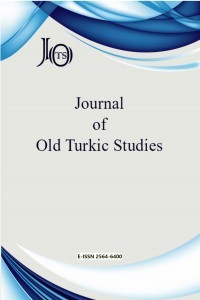Zu altuigurisch yemdük ‚Schamhaare‘
In this paper two Old Uyghur fragments are edited and discussed. Both are unique, and since there are no continuous lines their interpretation is extremely difficult. While the first one seems to be part of an unknown Buddhist sūtra, the other one belongs to a Buddhist confession text. In both remnants rare words occur, among them yemdük which is so far not attested in Old Uyghur.
Anahtar Kelimeler:
yemdük, Old Turkic, U 3109 and U 5000
On the Old Uygur yemdük ‘pubic hair’
In this paper two Old Uyghur fragments are edited and discussed. Both are unique, and since there are no continuous lines their interpretation is extremely difficult. While the first one seems to be part of an unknown Buddhist sūtra, the other one belongs to a Buddhist confession text. In both remnants rare words occur, among them yemdük which is so far not attested in Old Uyghur.
Keywords:
yemdük, Old Turkic, U 3109 and U 5000,
___
- AYDEMİR, H. (2013). Die alttürkische Xuanzang-Biographie IX, nach der Handschrift von Paris, Peking und St. Petersburg sowie nach dem Transkript von A. von GABAIN ediert, übersetzt und kommentiert, Band I-II, Wiesbaden: Harrassowitz Verlag.
- CLAUSON, S. G. (1972). An Etymological Dictionary of Pre-Thirteenth-Century Turkish, Oxford: Oxford University Press.
- DANKOFF, R.; J. KELLY (1982-1984-1985). Mahmut el-Kāşγarī: Compendium of the Turkic Dialects (Dīvān Luγāt at-Türk), Part I-II-III, Harvard: Harvard University Press.
- ERDAL, M. (1991). Old Turkic Word Formation, a functional approach to the lexicon, Vol. I-II, Wiesbaden: Harrassowitz Verlag.
- GARKAVEC, A. (2002). Kypčakskoe Pis’mennoe Nasledie I. Katalog i Teksty Pamjatnikov Armjanskim Pis’mom, Almatı: Desht-i Kypchak.
- LAUT, J. P. (2010). “Woraus besteht der alttürkische är ?”, Trans-Turkic Studies: Festschrift in Honour of Marcel ERDAL, Ed. M. KAPPLER et al, İstanbul: 51-66.
- UÇAR, E. (2017). “Kutadgu Bilig Dizinindeki Bir Kelime Hakkında II: alık ‘kötü, fena’ Üzerine”, Dede Korkut, Uluslararası Türk Dili ve Edebiyatı Araştırmaları Dergisi, 6/13: 63-70.
- WILKENS, J. (2007). Das Buch von der Sündentilgung, Edition des alttürkischbuddhistischen Kšanti Kilguluk Nom Bitig, Teil I-II, Berliner Turfantexte: 25. Turnhout (Belgien): Brepols Publishers.
- ZIEME, P. (2016). “Some Data on Old Uigur Traps”, Studia Linguistica Universitatis Iagellonicae Cracoviensis, 133: 309-318.
- Yayın Aralığı: Yılda 2 Sayı
- Başlangıç: 2017
- Yayıncı: Erdem UÇAR
